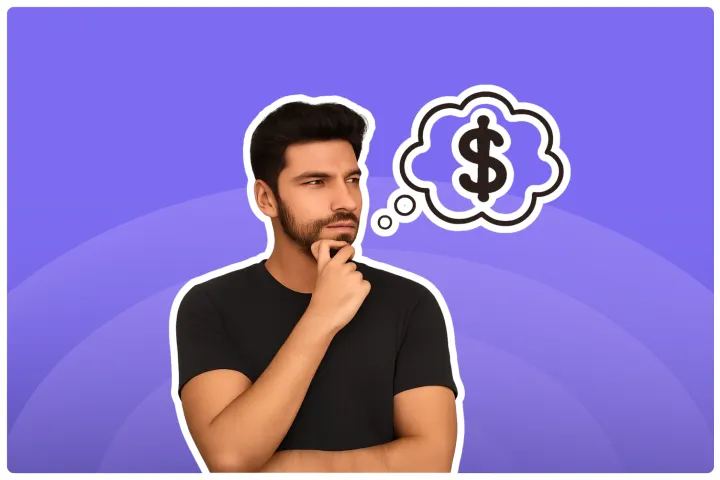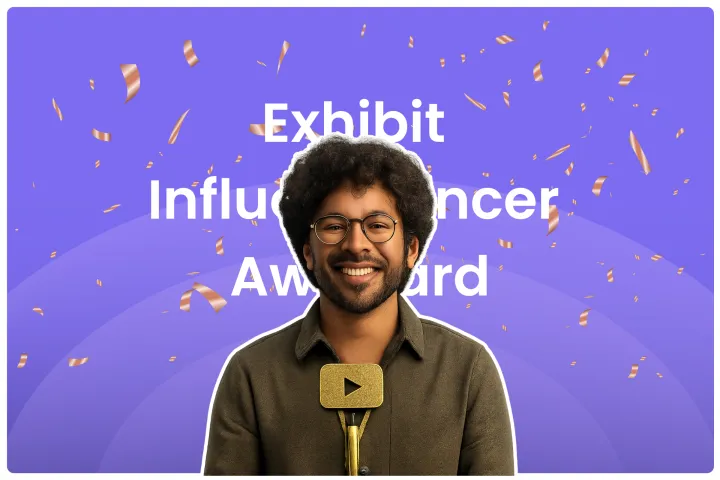What Is Paid Partnership On Instagram? A Guide (2025)
Curious about paid partnerships on Instagram? Check out our comprehensive guide to understand how they work and how to leverage them for success!

You pour your heart, soul, and countless hours into building a community that trusts you. You’ve built a vibe, a voice, and a following that hangs on your every word. Now, brands are starting to notice, and the dream of turning your passion into a paycheck feels closer than ever. But as you step into the exciting lane of brand collaborations, there's one feature you absolutely need to know inside and out: the "Paid Partnership with" label.
Think of this as your official badge of honour in the creator economy. It’s not just a setting on Instagram; it’s a powerful tool for building trust, gaining credibility, and unlocking serious growth. This guide will walk you through everything you need to know about using it effectively. Let’s get you paid!
What Is a Paid Partnership on Instagram?
A paid partnership is any collaboration where a brand compensates you for creating content. This compensation doesn't always have to be cold, hard cash (though we love to see you secure the bag, of course!). It can be anything of value:
- Money (the big one!): Direct payment for a post, Reel, or Story.
- Free Products or Gifts: The brand sends you products to feature. This is very common, especially when you're starting out.
- Services or Trips: A hotel might offer you a free stay, or a travel company might sponsor your trip.
- Commission: You earn a percentage of sales made through your unique link or code.
Whenever any of these exchanges happen, you are in a paid partnership. And that’s where the all-important label comes in.
The 'Paid Partnership With' Label On Instagram
Okay, real talk. Your audience is smart. They know when something feels like an ad. Trying to hide it can feel shady and damage the trust you’ve worked so hard to build. The "Paid Partnership with" label is your best friend here. It’s a clear, upfront way of saying, “Hey guys, I’m working with this awesome brand, and they’ve compensated me for this content!”

This transparency is no longer optional. It's the foundation of ethical influencing. In fact, a 2024 report highlighted that authenticity and transparency are key reasons why consumers trust influencers.
An iCubesWire report from January 2025 found that 82% of consumers admit that influencers impact their buying decisions, and 40% prefer influencers with niche expertise. This trust is your most valuable asset—don't break it. Using the label shows respect for your audience and protects your credibility.
How to Set Up a Paid Partnership on Instagram
Getting paid partnership label set up is super simple. It just takes a few taps before you hit "Share."
For Brands: Getting Your House in Order 🏠
Before you can even be tagged in a paid partnership post, you need to have the right setup on Instagram.
1) Switch to a Business Account:
This is step one, and it's essential. If you're still using a personal profile for your brand, it's time to switch! A Business Account unlocks a suite of tools designed specifically for businesses, including analytics and the ability to manage branded content partnerships.
How: Go to your Instagram profile > Tap the menu (three lines) > Settings > Account > Scroll down and tap 'Switch to Professional Account'. Follow the prompts, choose 'Business' as your category, and link it to your Facebook Business Page (recommended).
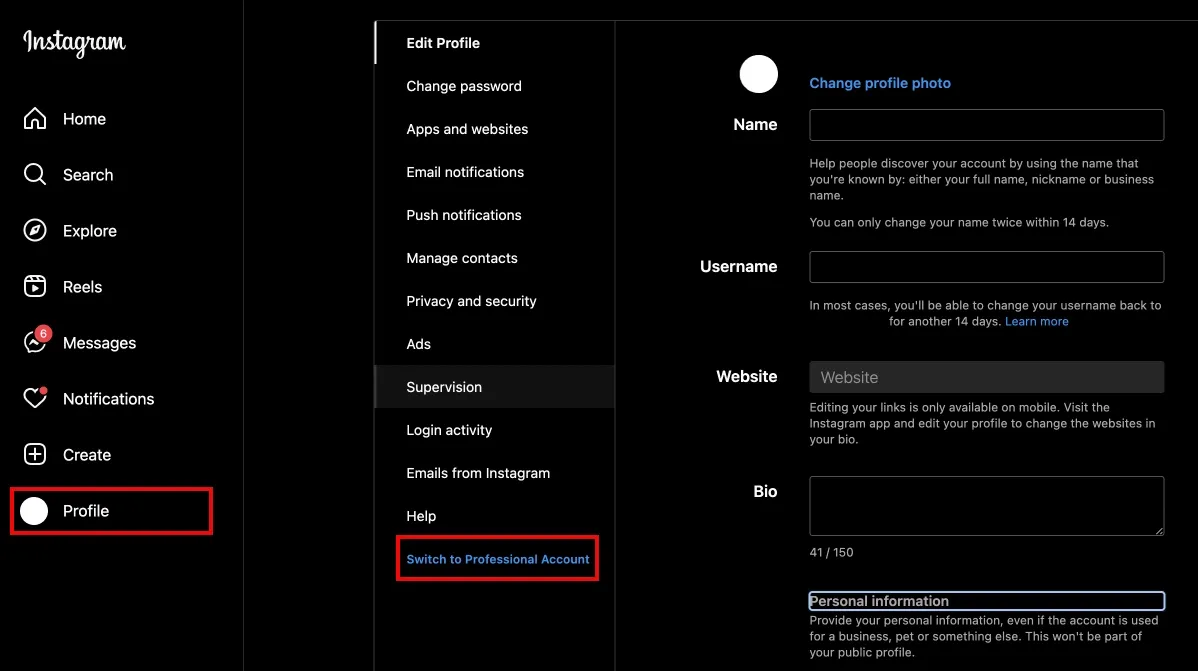
Why: Besides enabling paid partnerships, a Business Account gives you access to valuable insights about your followers and post performance, plus the ability to run ads directly. It signals to Instagram and potential partners that you're a legitimate business.
2) Enable Branded Content Tools:
Once you have a Business Account, you need to activate the tools that manage paid partnerships.
How: Go back to Settings > Business > Branded Content. Here, you'll find options related to approvals and managing partnerships. Ensure the 'Branded Content' tools are generally accessible or review the specific settings. A key setting here is 'Manually Approve Tags' (or similar wording – Instagram sometimes updates labels). It's usually recommended to keep this ON initially, giving you control.

Why: This section is your command center for paid collaborations. Enabling these tools allows creators to request to tag you and gives you the power to approve or deny those requests.
3) Approve Content Creators:
You need to grant permission for specific creators to tag your brand using the "Paid Partnership" label. You have two main ways to handle this:
Manual Approval (Recommended for most): Keep the 'Manually Approve Tags' setting enabled (as mentioned above). When a creator tries to tag you in a paid partnership post before you've approved them, you'll receive a notification. You can then review their profile and decide whether to approve them. You can also proactively search for creators you plan to work with and add them to an 'Approved Accounts' list within the Branded Content settings. This gives you maximum control.
Automatic Approval (Use with caution): You can disable the 'Manually Approve Tags' requirement. This means any creator could potentially tag your brand in a paid partnership post. This is generally NOT recommended unless you have a very open partnership program and trust the broader creator community implicitly. It’s usually safer to approve partners individually.
How to Approve Manually: Go to Settings > Business > Branded Content > Approved Business Partners. You can search for the creator's handle and add them to your approved list. Alternatively, when a creator you haven't pre-approved requests to tag you, you'll get a notification in your Activity feed and within the Branded Content section to approve or decline.
4) Collaborate with Creators:
Once the technical setup is done, the actual collaboration begins!
- Find influencers whose audience aligns with your target market.
- Reach out and agree on the campaign details (content, deliverables, timeline, compensation).
- When the creator makes their post, they will request to tag your brand using the paid partnership tool (see influencer steps below).
- You'll receive a notification to approve the tag. Once you approve it, the "Paid partnership with [Your Brand Name]" label will appear on their post.
For Influencers: Tagging Your Brand Correctly ✅
While your primary focus is the brand side, understanding the influencer's steps helps ensure a smooth process.
1) Switch to a Creator or Business Account:
Just like brands, influencers need a professional account (either Creator or Business) to access branded content tools. Most serious influencers will already have this.
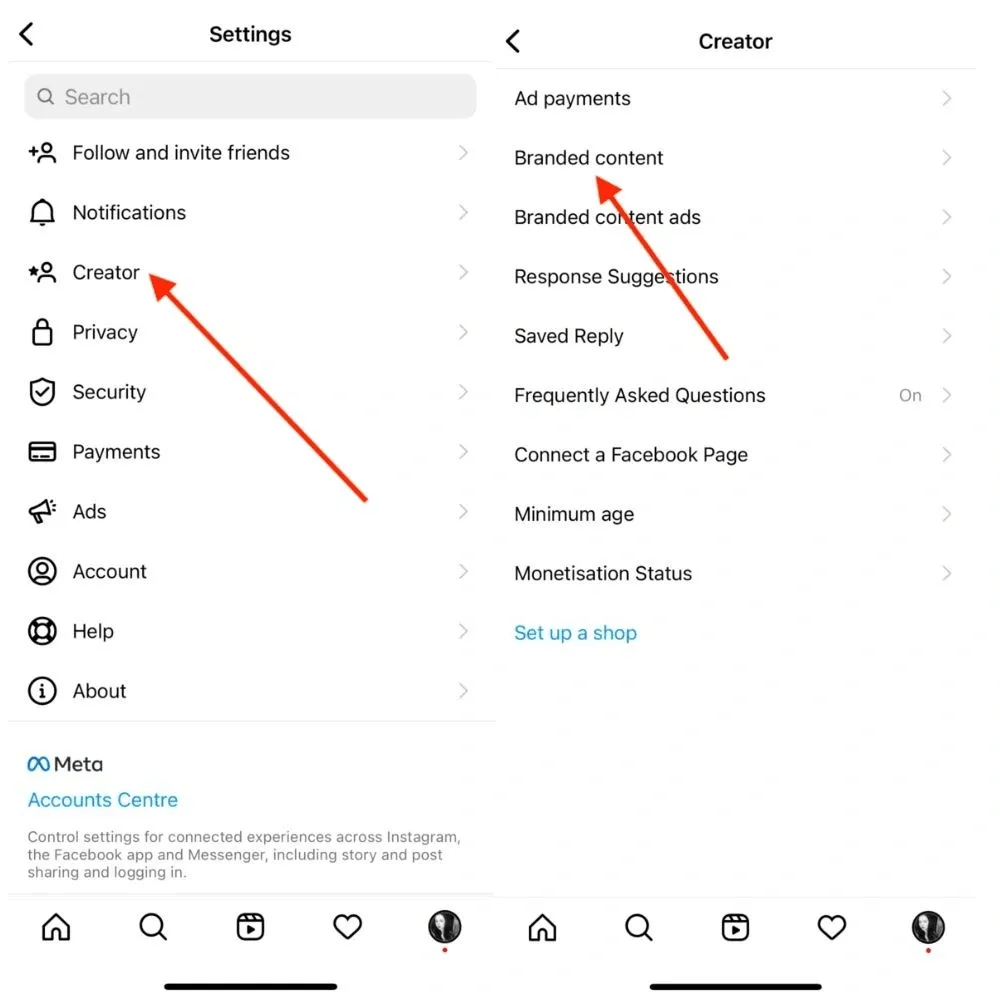
Why: This unlocks the specific feature allowing them to tag a brand partner.
2) Request Brand Approval (If not pre-approved):
When creating a Feed post, Story, or Reel that's part of your collaboration, the influencer needs to tag your brand using the specific branded content tool.
How (General Flow): During the usual post creation process (after editing, before sharing), there's an 'Advanced Settings' option. Within Advanced Settings, they'll find 'Branded Content'. They'll toggle this on and select 'Tag Business Partner'. They will search for and select your brand's Instagram handle. If you require manual approval and haven't pre-approved them, this action sends an approval request to you.

They usually can't publish the post with the tag until you approve it (though they might be able to publish without the tag initially and add it later once approved).
3) Add the 'Paid Partnership' Label:
Once you (the brand) approve the tag request (or if you've pre-approved them), the "Paid partnership with [Your Brand Name]" label will automatically be added to their content when they publish it (or it will appear if they add it after publishing). The creator doesn't type this label manually; it's generated by Instagram when the tag is successfully applied and approved.

Ensuring both sides follow these steps makes the process official, transparent, and unlocks key benefits.
Benefits of Using the Paid Partnership Label On Instagram
Using this label isn't just about following rules. It’s about unlocking powerful benefits that can supercharge your career as a creator.
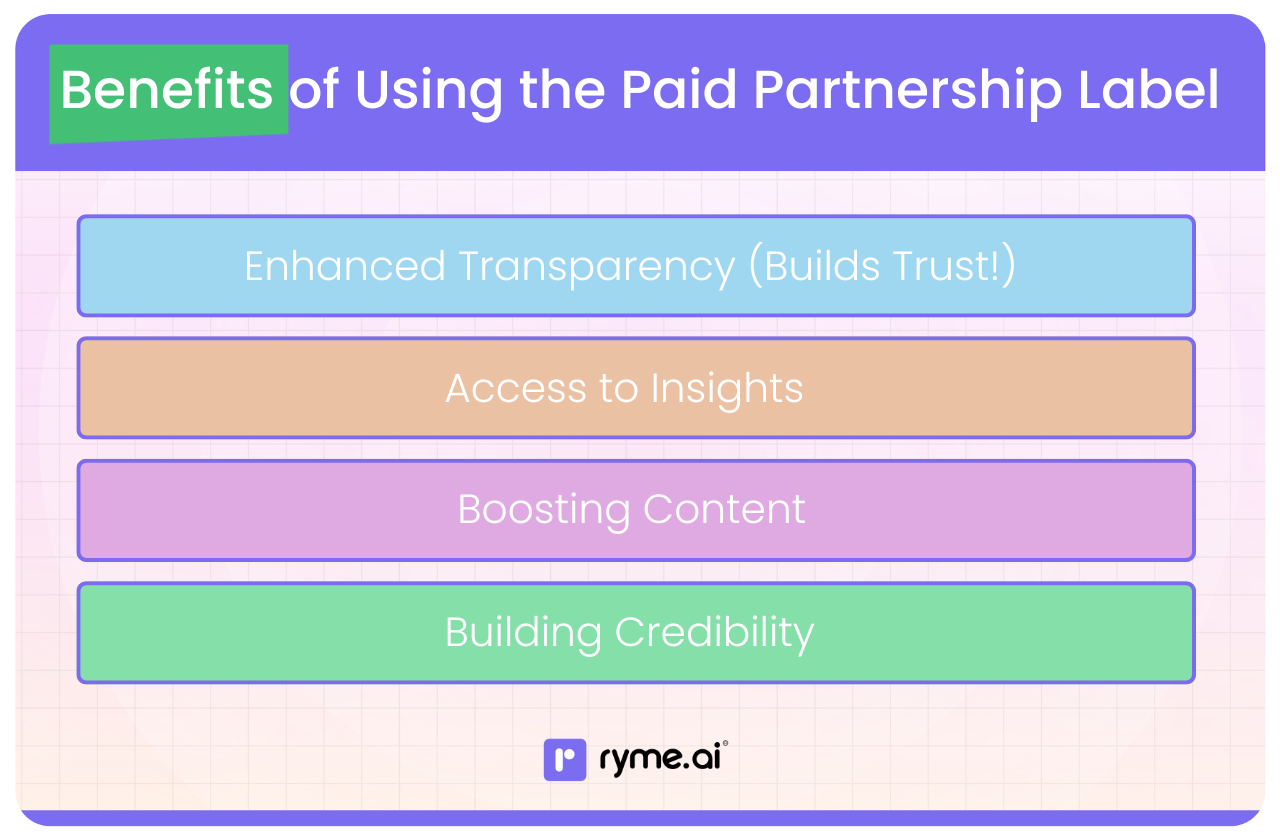
1) Enhanced Transparency (Builds Trust!) ✅
We’ve touched on this, but it’s worth repeating. Honesty is everything. When your followers see the label, they know you're being upfront. This builds a stronger, more authentic relationship. They’re more likely to engage with your content and trust your future recommendations because they know you value their trust.
2) Access to Insights (Know What's Working!) 📈
This is a game-changer. When you use the paid partnership label, both you and the brand get access to the post's performance metrics directly in your Instagram Insights. The brand can see the Reach, Impressions, and Engagement from their end, without you having to send screenshots. This makes you look incredibly professional and makes it easy for the brand to see the amazing results you're driving for them. It’s solid proof of your value.
3) Boosting Content (Amplify Your Reach!) 📢
Remember that "Allow brand partner to boost" toggle? This is pure magic. When you enable it, the brand can turn your authentic, high-quality post into a "Partnership Ad." They can put their ad budget behind your content to show it to thousands of people who don't even follow you yet. It’s a massive win-win:
- You get your content and profile exposed to a huge new audience.
- The brand gets to use your trusted voice to reach potential customers far beyond your follower list.
Partnership Ads often perform better than traditional ads because they come from a real person, not just a faceless brand account.
4) Building Credibility (Attracts More Opportunities!) ✨
Using the paid partnership label professionally signals to other brands that you are an experienced and trustworthy creator. It shows you understand the industry standards and take your collaborations seriously. This can make you more attractive to bigger brands and lead to more lucrative and long-term partnerships. For instance, growing your following can open up more opportunities; learn more about the income potential with a substantial following in our article on how much Instagram influencers earn in India.
Best Practices for Effective Paid Partnerships On Instagram
Okay, so you know why you should use the label and how to do it. Now, let's talk about making your partnerships as effective as possible.

1) Align with Relevant Brands (Find Your Tribe!) 🤝
The best collaborations feel natural. If you’re a fitness influencer, partnering with a protein powder brand makes sense. Partnering with a fast-food chain might confuse your audience. Only work with brands whose products you genuinely like and that fit your personal brand. Your followers will see right through a forced partnership. Check out how you can become a Myntra influencer for fashion-focused collaborations.
2) Set Clear Expectations (No Room for Confusion!) 📝
Before you create a single piece of content, get everything in writing. A solid influencer agreement is non-negotiable. It should clearly outline:
- The deliverables (e.g., 1 Reel, 2 Stories).
- The key message points the brand wants you to include.
- The posting dates and deadlines.
- Your payment (e.g., ₹50,000 for the campaign).
- Usage rights (can the brand use your content on their website?).
This prevents misunderstandings and ensures everyone is happy.
3) Monitor Performance (Track Your Success!) 📊
Don’t just post and ghost! Keep an eye on your Insights. See how your audience is reacting. Share a simple report with the brand a week after the campaign ends, highlighting the key metrics. This proactive approach shows your commitment and proves your worth for future projects.
4) Maintain Authenticity (Keep it Real!) 💯
Here’s the secret sauce: the sponsored post should still sound like you. Don't just copy and paste the brand's marketing jargon. Weave the product into your content in a way that feels genuine.
For example, travel creator Riya (@WanderlustRiya) recently partnered with a sustainable luggage brand. Instead of just posting a picture of the suitcase, she created a Reel showing how she packs it for a weekend trip, highlighting its features in her own fun, energetic style. The "Paid Partnership" label was there, but the content felt 100% Riya. That's the goal!
How ryme.ai Enhances Paid Partnerships On Instagram
Navigating the world of brand deals can be tough. How do you find brands? How much should you charge? How do you manage contracts? That's where platforms like ryme.ai come in.
ryme.ai is an AI-powered platform designed to make your life as a creator easier. We connect you with brands that are the perfect fit for your niche and audience.
Key Features Designed for You:
- AI-Powered Brand Matching: Our smart system connects you with brands that are actively looking for creators just like you. No more cold-pitching!
- Transparent Campaign Details: See all the requirements, deliverables, and payment terms upfront before you even apply.
- Streamlined Management: Manage all your collaborations, from application to payment, in one simple dashboard.
- Secure & Instant Payments: Forget chasing invoices. Get paid securely and on time, every time.
How ryme.ai Addresses Common Pain Points:
- "I can't find brands to work with." → Our platform brings the opportunities directly to you.
- "I don't know how much to charge." → We provide guidance and ensure fair compensation for your work. You can also read our guide on how much influencers charge in India.
- "Negotiating contracts is intimidating." → We use standardized agreements to make the process clear and hassle-free.
Conclusion
The "Paid Partnership" label is so much more than a requirement. It’s a tool for growth, a symbol of trust, and a mark of professionalism. By embracing transparency and using the features Instagram provides, you build a stronger connection with your audience and open the door to more exciting and lucrative brand deals. You're not just an influencer; you're a business owner, and this is how you run your business like a pro.
Instagram Paid Partnership Related FAQs
1) How do you get a paid partnership on Instagram?
Start by building a strong, engaged community in a specific niche. Create high-quality, consistent content. Once you have an engaged following, you can start reaching out to brands you love or use a platform like ryme.ai to connect with brands looking for creators.
2) How much is a paid partnership on Instagram?
The payment for a paid partnership varies widely. It depends on your follower count, engagement rate, niche, and the scope of the collaboration. A nano-influencer (1k-10k followers) might charge a few thousand rupees (e.g., ₹5,000 - ₹15,000) for a post, while a macro-influencer (100k-1M followers) can command lakhs. Check out our detailed guide on how much influencers charge in India for more insights.
3) What is the benefit of a paid partnership on Instagram?
The main benefits are building trust with your audience through transparency, gaining access to shared post insights with the brand, allowing the brand to boost your content for wider reach, and establishing yourself as a credible, professional creator.
4) How does a paid partnership work?
It's a simple process: 1. A brand and creator agree on a collaboration. 2. They sign an agreement detailing deliverables and payment. 3. The creator produces the content. 4. The creator publishes the content using the "Paid Partnership with" label. 5. Both parties analyze the results.
5) Is it good to add paid partnership on Instagram?
Yes, it is essential! It is the ethical and required way to disclose a commercial relationship. It builds trust, protects your reputation, and unlocks valuable features for both you and your brand partner.
6) How does a paid partnership work?
A paid partnership involves a brand compensating a creator for content. The creator then discloses this relationship to their audience by using Instagram's "Paid Partnership with" label on the sponsored post, Reel, or Story.
7) How many followers do you need for paid partnerships?
There's no magic number. Brands are increasingly collaborating with nano-influencers (1,000-10,000 followers) and micro-influencers (10,000-100,000 followers) because of their high engagement rates and niche audiences.
A 2024 study from Temple University's Fox School of Business highlighted that micro-influencers are particularly effective in reaching Gen Z consumers who value authenticity. Focus on building a strong, engaged community, and opportunities will follow, regardless of your follower count.
For more on this, read our blog on how many Instagram followers you need to make money.


